Overwintering plumeria indoors is simple, and caring for them during the winter doesn’t take much effort.
In this post, I’ll show you three ways for how to keep your plumeria through the winter in cold climates, so you can continue to enjoy it for years to come.
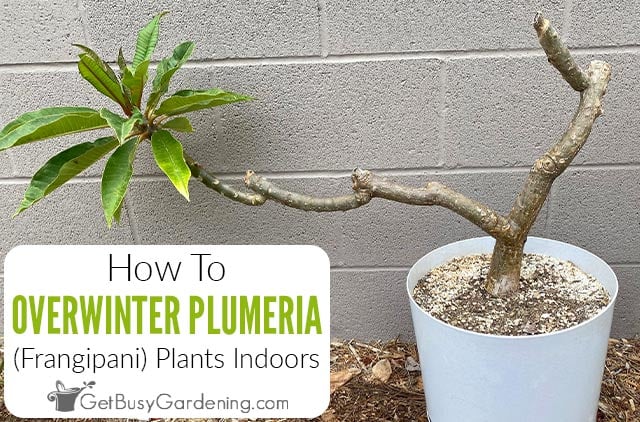
If you live in a cold climate like I do, then you know just how unique it is to have a plumeria. But of course we also know that these spectacular tropical beauties won’t survive our harsh winters outside.
The good news is that overwintering plumerias is very easy, and doesn’t take much work on our part to save them.
With a minimal amount of time and maintenance, you’ll be able to enjoy them for many, many years no matter where you live.
In this guide, I’ll share all my best tips for how to overwinter a plumeria plant with one of 3 simple methods.
I’ve been doing this for over 20 years, and I’ve made every mistake in the book. So I’m happy to share everything I’ve learned so you can be successful.
Plumeria Temperature Tolerance
Plumeria (Frangipani) – also commonly called the Hawaiian lei plant – has a very specific temperature tolerance. It thrives in tropical climates of zones 10 and above, so it doesn’t like the cold.
The lowest temperature it can handle is 32°F (0°C), but only for short periods of time. Though it can take some light frost, a hard freeze will kill a small plant, or severely damage a large tree.
Methods Of Overwintering Plumerias
There are three ways to protect and overwinter your plumerias so it will live until spring.
It’s fun to experiment, so try all three if you have more than one plant. Otherwise, choose the one that’s most appealing to you.
- Keeping it alive as a houseplant
- Storing it in its dormant state
- Overwintering plumeria cuttings
Related Post: How To Overwinter Plants: The Complete Guide
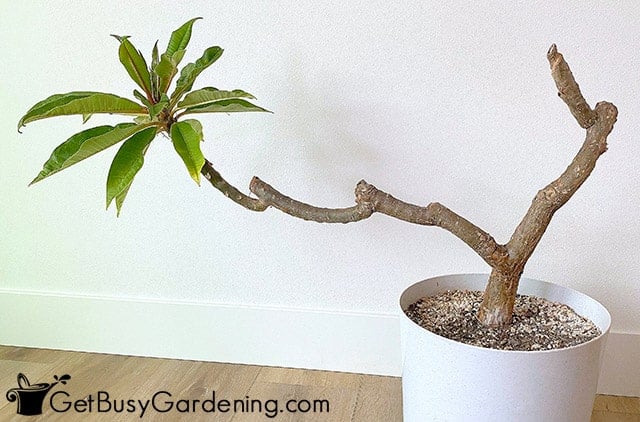
How To Overwinter Plumeria Plants
Below I will talk about each of the three methods for overwintering plumeria in detail.
Choose the one that sounds easiest to you, there’s no right or wrong way to do it. If it ends up not being ideal, then try a different way next year.
1. Keeping Frangipanis As A Houseplant Through Winter
It is possible to keep your Hawaiian lei plant alive through the coldest months as a houseplant. Heck, you might even get lucky and enjoy a few blooms while it’s inside.
But in order for this to work, you should move it indoors before the temperature drops below 60°F (15.6°C) to prevent dormancy.
If you put it in front of a sunny window right away, it shouldn’t droop or drop its leaves. But if it does drop a few, it should recover quickly.
However, if all of the leaves start dying and falling off that means it’s going dormant, so you’ll need to use method #2 instead.
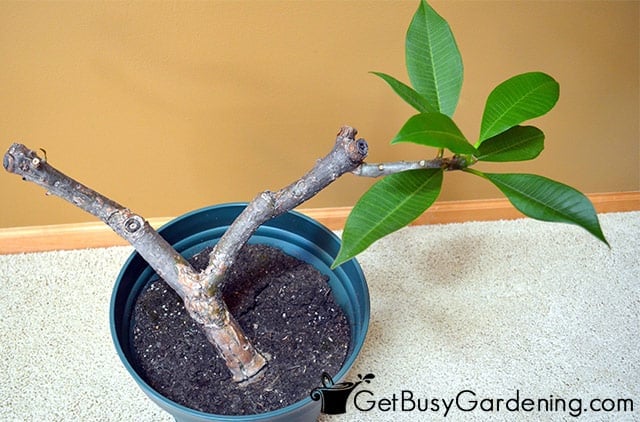
2. Overwintering A Dormant Plumeria Plant
Forcing dormancy is a smart way to overwinter plumeria. Especially if you don’t have a spot where it will receive daily sunshine.
This is my preferred method, since winter dormancy is normal for them. For me, this is much easier than trying to keep it as a live plant.
To trigger dormancy, stop watering it in the fall and expose it to cooler temperatures. You can leave it outside until it gets down into the 40s°F, but protect it from frost.
The leaves will turn yellow and then brown before they fall off, and that’s normal. Once it gets too cold outside, move it to a cool, dark location inside where you can store it until spring.
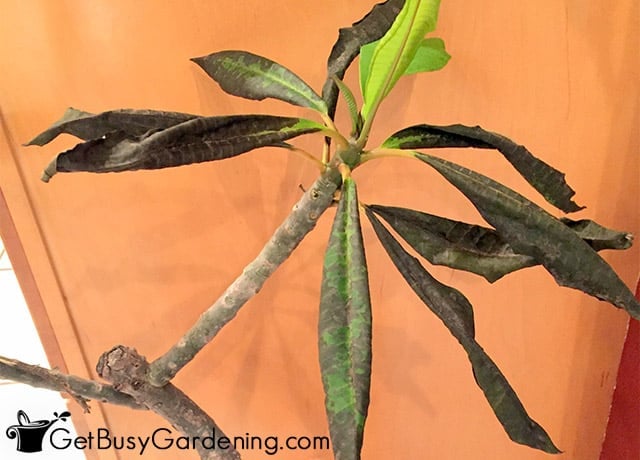
3. Wintering Plumeria Cuttings Indoors
If your plumeria is too large to bring inside, you can take cuttings to overwinter instead. This is a good option if you don’t have the space for keeping or storing a full-sized plant.
You can either try to root them right after bringing them indoors, or keep them dormant all winter. They don’t root well in the fall, so you’ll probably have more success if you store them.
To do that, remove all of the largest leaves from cutting, and let it cure (dry out) for several days. Then put it (uncovered) in a warm, dry, and dark location until spring.
Dormant cuttings can survive a few months in storage with no problem. Learn how to propagate and root plumeria cuttings here.
Bringing Plumeria Indoors For Winter
When you’re ready to bring your Frangipani indoors as the colder weather arrives, it’s important to do it a the right time. Follow these tips for best results.
When To Bring Frangipani Inside
Deciding when to bring your Frangipani inside depends on which overwintering method you will be using.
For live plants and cuttings, bring them in before the weather dips below 60°F (15.6°C). This is usually several weeks prior to your average first frost date in the fall.
If you’re planning to let them go dormant, you can wait until the temperature falls to as low as 40°F (4.5°C). But take care to protect them from frost.
How To Bring Plumeria Indoors
Before you move them inside, follow these instructions for debugging them first so you don’t bring in any unwanted pests.
You might also want to prune or cut it back so that it fits in your room. You can safely remove up to 3/4 of the leaves without damaging it or forcing dormancy.
For houseplants, select a sunny spot that will provide ample light. Otherwise for dormancy, place it in a dark corner or room.
Related Post: How To Grow Plumeria In A Pot
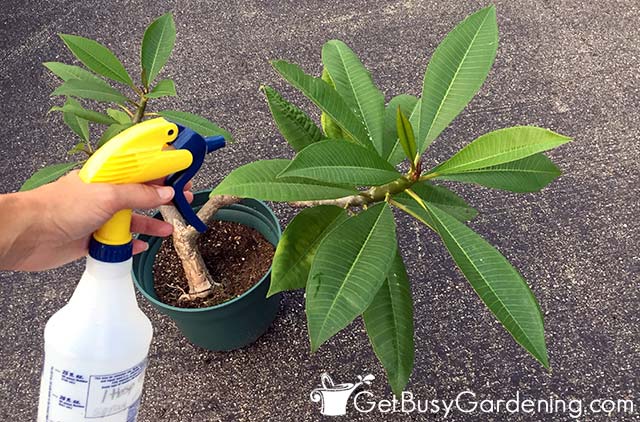
Plumeria Winter Care Tips
Keeping a plumeria alive through the winter indoors is not extremely difficult, but there are some challenges. Follow these tips if this is the method you want to use.
You can learn all about growing plumerias here, but below I’ve included some specific winter care tips.
Light Requirements
To keep them thriving, they need plenty of light. Either place it in front of a sunny south-facing window, or use grow lights.
Keep in mind that even if you are overwintering a live plumeria, they still go into a semi-dormant state during the cold and dark season, so they won’t grow very much.
But if you notice it’s starting to get leggy or reaching for the window, then it needs a sunnier spot, or the addition of artificial light.
Related Post: How To Choose The Best Plumeria Soil
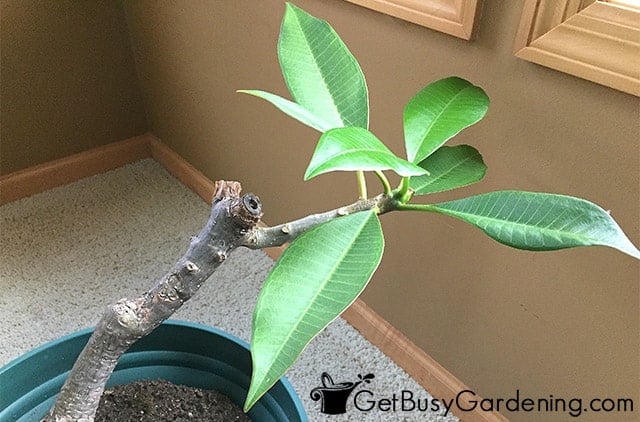
Watering In Winter
Just like most plants, this one needs much less water during the winter. Do not overdo it, or the stem could start to rot. Overwatering is the biggest mistake that people make.
So only moisten the soil when it is completely dried out. Use a moisture meter gauge to help you make sure it’s receiving the perfect amount.
If you’re storing it dormant, don’t give it any water at all until you’re ready to start waking it up in time for spring.
Controlling Bugs
One of the biggest benefits of overwintering plumerias dormant is that you don’t have to worry about bugs. For live plants, that can be a different story.
Spider mites, mealy bugs, and scale insects are a few of the most common pests that you might experience.
If you find any bugs, use an organic insecticidal soap to wash the leaves. Or make your own using 1 tsp of mild liquid soap to 1 liter of water. Neem oil is also a very effective natural insecticide that works great.
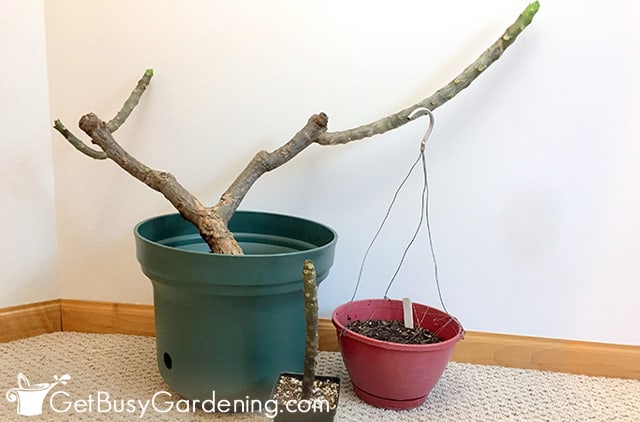
Bringing Plumeria Out Of Dormancy
If you decide to overwinter a dormant plumeria, then follow the tips below to bring it out of its sleep once the weather begins to warm up.
When To Start Waking It Up
You should start to wake it up from dormancy sometime in mid to late winter – or a month or two before your last frost date.
When you begin breaking dormancy that early, it will have plenty of time to get some new leaves before moving it back outside in spring.
Be patient because it can take a month or more before you see any signs of life. Don’t try to force it to wake up faster, just let it happen naturally.
How To Bring Plumeria Out Of Dormancy
All you need to do to bring your plumeria out of dormancy is expose it warm sunshine and give it more water. Start by moving it to a sunny room, and water it deeply.
Let the extra water drain completely from the pot, and don’t give it anymore until it begins to get leaves.
Once you see new leaves, start feeding it a diluted 1/4 dose of liquid fertilizer or a compost tea every time you water. This is also a great time to add slow-release pellets.
Learn even more about how to bring plants out of dormancy here.
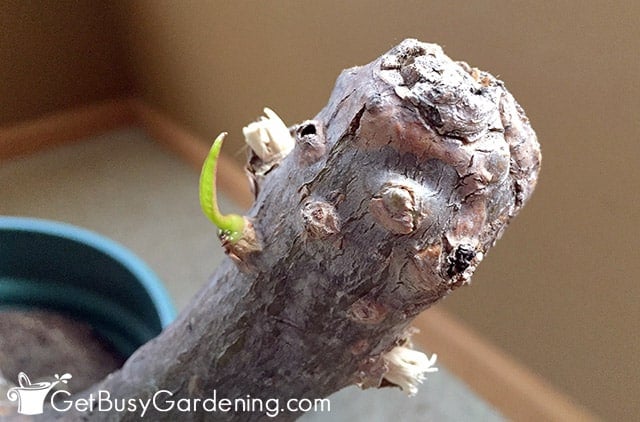
Moving Plumeria Back Outside After Winter
When it comes time to move your plumeria back outside after winter, you’ll probably be very excited.
But if you do it too fast, you could wind up damaging or even killing it. So be sure to follow these tips for the best success.
When To Put Your Plumeria Back Outside
You can put your plumeria back outside after all chance of frost is gone in the spring. The overnight temperatures should be 50°F (10°C) or higher.
To be safe, I recommend waiting until after your last frost date. If there’s a late cold snap in the forecast, then move it into a garage or back inside for the short term to protect it.
How To Move It Back Outside
Regardless of whether you let them go dormant or kept them alive, you need to slowly acclimate them to being back outside again.
They’re used to the less intense light indoors, so putting them into the direct sun right away can burn their leaves and stems.
To harden them, place them in a shady spot outdoors for several days. Then slowly move them into more sun over the course of a few weeks. Once they get used to it, you can put them back in their full sun location.
Overwintering Frangipani FAQs
Here are some questions people often ask about overwintering plumeria. If you don’t see your answer here, please ask about it in the comments below.
Do plumerias go dormant in the winter?
Most of the time plumerias do go dormant in the winter, and this is their natural life cycle. However, if it’s warm enough and they get plenty of light, they will keep their leaves, and sometimes even flower in the winter.
Can I overwinter plumeria in an unheated garage?
You can overwinter plumeria in an unheated garage as long if it stays above 40°F. I keep mine in my unheated garage in the fall to protect it from frost and force dormancy, then bring it into the house once it gets too cold out there.
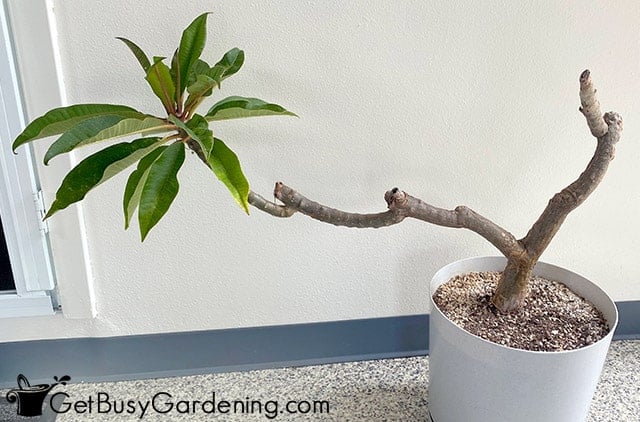
Do frangipanis lose their leaves in winter?
Frangipanis lose their leaves in the winter if they go fully dormant. Otherwise, they do not drop all of their leaves.
Can I leave my plumeria plant outside over winter?
You can leave your plumeria plant outside over winter if you live in zones 10 or higher. But, if the temperatures get consistently below 40°F (4.5°C) outside, then you must bring it indoors in order for it to survive.
How much cold can a plumeria tolerate?
A plumeria cannot tolerate very much cold since it is a tropical plant. Though it can survive brief periods of temperatures down into the 30s°F, it prefers a minimum of 50°F (10°C).
How do you winterize a potted plumeria?
To winterize your potted plumeria, move it indoors to an area that stays above freezing. If you want to overwinter it as a live plant, place it in a sunny window. Otherwise store it in a cool, dark room where it will go dormant. Either way, keep the soil on the dry side through the winter.
When you follow this guide, you’ll know exactly how to overwinter your plumeria so that it outlasts the cold weather. Then, you’ll have spectacular blooms to enjoy again in the spring and summer.
If you want to learn all there is to know about maintaining healthy indoor plants, then you need my Houseplant Care eBook. It will show you everything you need to know about how to keep every plant in your home thriving. Download your copy now!
More About Overwintering Plants
- How To Overwinter Tropical Hibiscus Plants Indoors
- Overwintering Caladium Bulbs: Digging, Storing & Winter Care Tips
- How To Overwinter Pepper Plants Indoors
Share your tips and techniques for overwintering plumeria in the comments section below.


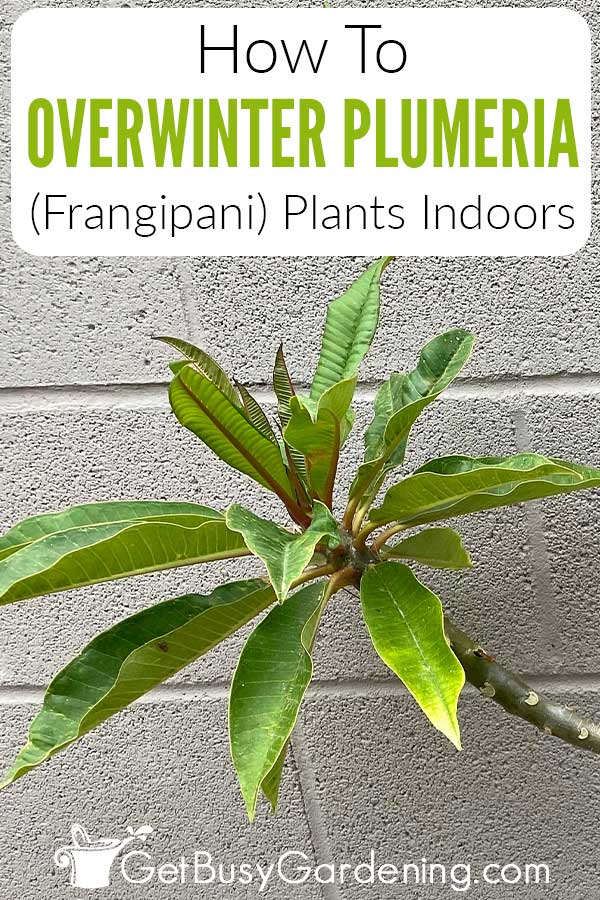



Plumie says
So, we’ve had a plumeria for years (longer than we’ve been married) and have never pruned or clipped or trimmed or anything. We’ve been so afraid of damaging “her” aka Plumie. But your article inspired me. She’s more a tree. She needs help. We’re also in MN now (ten years is “now”) and she’s way happy here. I’m glad to know we can force dormancy. I mean. Read a book, right? But her blooms are amazing. And we’re just learning about our 15 year old plant.
Linda Cline says
I moved to Corpus Christi Tx in 2022 to and the house I bought has a large plumeria planted in the ground. We are expecting some mid 20s for next few nights. Can I cover it with blankets to keep it from freezing and dieing??
Amy Andrychowicz says
You should definitely try covering your plumeria plant during the cold snap. But if it stays that cold for very long, then it will probably still cause damage. Be sure to use a heavy cloth or blankets to cover it, and not plastic.
Natalie says
Hi I’m in MIssouri I brought back 2 plumeria stalks from Hawaii in September this year. I potted them like directed and kept outdoors- I have brought them in doors since our temps drop fast. Neither of them have made any leaves. I have watered them if completely dry. Should I just not water them? I’m not sure since they were stocks if they were dormant or not? There is some green in color around edge . Just wanting them to survive .
Amy Andrychowicz says
Yes, it may be too late in the year for your plumeria cuttings to form roots and break dormancy. I have successfully overwintered cuttings in soil before, so that’s the route you might want to take. Just let the soil dry completely, then give them very light drinks through the winter (just enough to barely moisten the soil so it doesn’t stay completely bone-dry all winter). Once it starts warming up in the spring, give them more water and move them to a sunny location. That should break their dormancy so they’ll finally start growing. Here’s more information about overwintering plumerias that might help you out too.
Joh says
Hi Natalie,
I live in Missouri and agree with Amy that it’s too late in the season to root a plumeria in our zone 6 successfully. In August we had a storm that knock over my potted plumeria. One of the limbs broke off but instead of trying to root that cutting I decided to store the cutting in a dark area of my basement until next spring. I recommend that you remove your cutting from the potting soil and store them until spring. When you replant your cutting in the spring dip the end in rooting powder/gel, water deeply and do not water again until you see a few leaves and even then water sparingly. Due to our relatively short growing season I never attempt rooting plumeria cuttings beyond mid-July.
Jo An Hays says
Hello Amy, I’m new to growing Plumerias, I started 3 months ago. First I got 3 stalks followed directions on planting and they are doing great! Six or seven leaves so far with more baby ones. I bought 8 new small potted plants and they have really grown fast. I know have a total of 15 plumeria yes, I’m addicted. My question: I have all my plumerias in an enclosed patio, that I have had for 3 months it’s now turned into a sunroom. The plumerias definitely like the east facing window where they get direct sun from 8am to 1pm after that they get indirect light. The temperature in crazy hot Texas has been in excess of 110f which I thought might be too hot, but the plumerias are thriving. I had the biggest surprise a few days ago when I saw an inflow! It now has two beautiful pink blooms and more to come. I don’t know how cold it will get in the sunroom this winter, but I do have central heat out there so I can keep the temperature at 60f. Since the sunroom is all windows there will be plenty of light. Should I leave them alone during the cold months to see if they go dormant or water when they dry out? I appreciate your help.
Amy Andrychowicz says
Yes, I would definitely let your plumerias dry out a bit more during the winter. Even if they don’t go fully dormant, their growth will naturally slow down because of less light and cooler temperatures, so they won’t use as much water. They may or may not drop their leaves, it depends on the type of plumeria, as well as the environment. I’ve had years where mine has dropped all of its leaves and gone fully dormant, and other years where it has kept its leaves, but didn’t grow at all during the winter. So it can vary year to year.
Debbi says
We live in Ohio and are considering using an outdoor greenhouse on our deck to winter our plumeria. Is this possible? If so, what tips can you provide. Thanks!
Amy Andrychowicz says
You would only be able to overwinter your plumeria in an outdoor greenhouse if it never freezes. The temperature should stay above 40°F at all times, and ideally between 45-50°F for the best success in keeping your dormant plumeria alive.
Chandni Agarwalla says
Hi! I have a couple cuttings that put out leaves during the summer in zone 7a and now it’s indoors. The room the have it in is partly sunny and I only water when the soil completely dried out. But I, noticing the leaves falling off and some of the stems are getting wrinkly and shriveled looking. What should I do?
Amy Andrychowicz says
It’s normal for plumerias to drop their leaves as they go dormant for the winter. However, if the stem is getting wrinkly, then I would check the base of it to make sure it’s not rotting. If it’s ok, and the soil is completely dried out, then you can give it a little water to help it rehydrate a bit. But be careful, it is very easy to overwater when they’re dormant.
Judy Walker says
Amy, I want to overwinter my plumeria inside my house using the dormancy method, so that means no watering until waking them up. We keep our house temp around 70 in winter. I brought them inside when temps started to dip below 60. They are in a south facing room that I can keep dark but so far I have let some light filter in.
Should I keep them in the dark and am I okay not to water at all at 70 degree indoor temp? The soil is completely already dried out as of November 30th. Thanks, I just love these plants!
Amy Andrychowicz says
This sounds like a good overwintering plan to me, especially if your plumeria is large and well established in it’s pot. There’s no need to give it complete darkness though. I keep mine in my living room across the room from the windows so it doesn’t get any direct sun, and it’s perfectly happy there. Mine is in a 14″ pot, and it can go all winter without water. But if yours is a small plant or new start, then you can moisten the soil now, and check it every few weeks throughout the winter. If the soil becomes so bone-dry that it’s pulling away from the inside of the pot, you can give it a little water. But it’s very easy to overwater them when they’re dormant, so it’s definitely best to keep it dry.
Rae says
I have three plumerias that I brought home from Hawaii as cuttings. I have a very difficult time getting them to bloom every summer. Does dormancy affect blooming ? I usually put them in a sunny window and water lightly through the winter, but am wondering if I should force dormancy.
Amy Andrychowicz says
No, dormancy does not affect the flowers, but it’s much easier to overwinter plumerias indoors that way. The best way to get them to bloom is lots of sun and regular fertilizer. I recommend reading my detailed plumeria care guide as well as my article about how to grow them in a container for tons of tips and more information.
Gale says
Hi Amy,
I live in Atlanta Georgia and have 5 plumeria plants. A couple of them are quite large. I was out of town last week and it rained a lot while I was gone. This week the temperatures are dropping. I brought my plants into the garage but the soil is very wet. What should I do? Same for my Hibiscus and lemon trees.
Gale
Amy Andrychowicz says
All you can really do at this point is allow the soil to dry out before watering again. If possible, you could try sliding the entire rootball out of the pot, and that way it will dry faster. If there aren’t drainage holes in the bottom of the pots, then definitely drill some so the excess water can completely drain away.
Gale says
Thank you. Some of the smaller ones o did take the root ball out and wrap in newspaper. The large ones I have just left alone and so far they have all seemed to be fine.
Amy Andrychowicz says
You’re welcome. I hope they all get through the winter and thrive for you next year!
Anna May says
When you talk about temperatures, is that day or night time temperatures. I live in Montana and during the winter months I bring them in doors so far so good. Right now the night time temperatures is at about 45F, is that still ok to keep them outside?
Amy Andrychowicz says
Whatever the lowest temperature is, day or night doesn’t matter. Leaving it outside down to 45°F will definitely trigger dormancy. I bring mine in once it gets that cold, simply because I get nervous that we’ll get a freak frost, which is pretty common in the fall in MN (unpredictable weather, and 45°F is too close to frost temps for my comfort level 🙂 ).
Karen Snitjer says
Hallo Amy
Mijn plumeria bloeit al niet meer sinds ik hem drie jaar geleden heb gekocht. Hij staat in de winter op mijn slaapkamer( ongeveer 16 graden celcius) en laat dan het grootste gedeelte van zijn bladeren vallen.
Pas in mei beginnen er weer nieuwe bladeren te komen. Eerst krijgt hij dan wekelijks gewone, vloeibare mest en als er meerdere bladeren zijn krijgt hij 52-10-52 mest voor de bloemen. Wat doe ik fout en waarom bloeit hij niet?
Groetjes,
Karen uit Holland
Amy Andrychowicz says
They are heavy feeders, and need lots of nutrients in order to bloom in pots. Start feeding as soon as your plumeria puts on its first few leaves in the spring, and don’t stop until a month before you plan to bring it indoors for its winter dormancy. Keep feeding it weekly, and you can also add granules monthly. I recommend switching to a natural/organic brand though, as synthetic products can actually strip nutrients from the soil over time, and cause other issues. I would also try repotting it into fresh, rich, fertile soil once it gets its first few leaves in the spring. This post has tons of info about fertilizing and reblooming… How To Care For Plumeria Plants
Patrik Nilsson says
Hi Amy,
I first saw frangipanis at my friend’s place in Durban, South Africa when I studied there over 20 years ago, but was told that they would never survive in Sweden. Now I read your very detailed description of how to keep them alive in a colder climate and it just made my day. I immediately started looking for cuttings and found a site in the UK and they even had the Symphony which is the closest variety to the tree I have admired so many times. Now I can hardly wait until it gets a little warmer for safe shipping, AND my friend’s frangipani will definitely see some “pruning” next time I visit (cheered on by my daughters who also fell in love with the “helicopter flower tree” once they were shown it on a trip many moons ago). Best, Patrik
Amy Andrychowicz says
Wonderful, happy to hear that you found this article so helpful! My plumeria has gone through almost 20 winters in my basement in MN, and it’s happy as can be. Good luck, and enjoy your new babies when you get them. 🙂